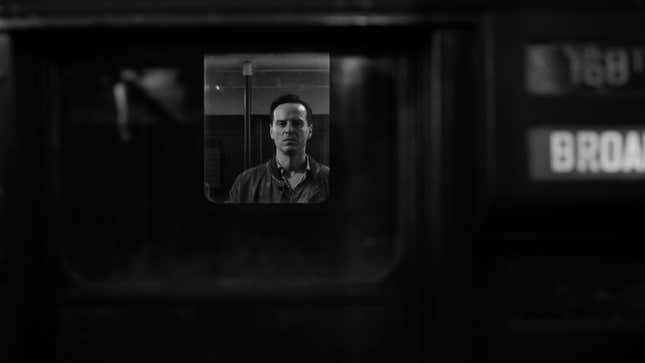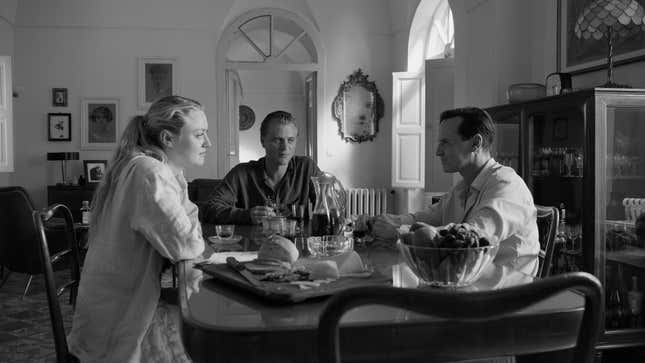
It’s been more than 20 years since the Talented conman Mr. Tom Ripley last stalked our screens. Best known to modern audiences through director Anthony Minghella’s 1999 adaptation starring Matt Damon, Ripley was last played by John Malkovich in the under-seen (and fun-as-hell) Ripley’s Game, which should give some sense of the various types of performers who walked in Ripley’s stolen shoes. Before Malkovich and Damon, French heartthrob Alain Delon and domestic lunatic Dennis Hopper had turns. Ripley attracts elite actors, and in Steven Zaillian’s masterful Ripley Netflix series (out April 4), Andrew Scott may have surpassed them all.
Ripley’s DNA is spattered across the television landscape. Traces can be found in Hannibal’s tours of Italy and queer subtext that’s often made text and You’s slippery Joe Goldberg, whose elaborate murders and methodical cover-ups could easily be mistaken for Tom’s. In another world, Penn Badgley would’ve made a great Ripley. We’ll suffice for a slightly too-old Scott.
Written and directed by Oscar-winning screenwriter Steven Zaillian, all eight episodes of Ripley more or less faithfully follow the plot of Patricia Highsmith’s original Ripley novel, 1955’s The Talented Mr. Ripley. Tom Ripley is still a low-rent New York grifter getting by in the early ’60s. After one of his many schemes goes sideways, a shipping magnate hires Tom to bring home his layabout failson, Dickie Greenleaf (Johnny Flynn), who’s been “painting” in Atrani, Italy, with girlfriend Marge Sherwood (Dakota Fanning).
In Atrani, Dickie and Marge greet Tom with apprehension that gives way to an uneasy friendship. As Tom grows obsessed with Dickie and tired of Marge, he quietly weasels his way into Dickie’s home and drives a wedge in his relationship. When Dickie makes it clear that he’s not going to elope with Tom, Tom kills Dickie, assumes his identity, and spends the next few months living off Dickie’s trust fund in Rome while keeping up appearances as Dickie.
Though a tad too old for the role (Ripley is 23 in the books; the actor is pushing 50), Scott is a quiet, unassuming terror as Tom. He can blend into a crowd or be the most captivating person in it. With an American accent that occasionally has the lilt of Mark Ruffalo, Scott plows through the implausibilities of the Ripley story and worms his way into the viewer’s graces as he does the people around him. Scott works this into the character with a meticulously improving “Dickie” impression, picking up on slight hints of Flynn’s delivery and creating subtle distinctions between the two characters. Like a grim and gay Mrs. Doubtfire, this creates situations when Scott, with unshakable confidence, must play a convincing Tom for people who have seen him as “Dickie.” Tom pulls all this off with an artist’s touch using light and shadow.
The supporting cast elevates Scott’s commitment. As poor Marge, the hopeless author-photographer-ex-girlfriend, Fanning brings believable naivety that borders on dopiness. Her powerlessness and frustration are understandable and pathetic as Tom makes a mockery of her life. The tenacious Roman Inspector Ravini (played with stone-faced judgment by Maurizio Lombardi) and suspicious Freddie Miles (Eliot Sumner, who hints at the queer underground of Tom’s New York) never give Ripley an inch, backing him into a corner like a caged rat.

Save for the final episode, which diverges slightly from Highsmith’s novel, Zaillian makes a meal of her every word. He gives the work texture through Oscar-winning cinematographer Robert Elswit’s striking black-and-white photography, so achingly crisp that lines on each actor’s face are as craterous as the cracks along the walls of Atrani’s decaying architecture. There’s no boring coverage here. Each shot is purposeful, with unique setups and compositions. Close-ups of stone faces decorating Roman and Venetian buildings add to a noir atmosphere that recalls The Third Man, turning Italy into a country of surveillance and paranoia. Statues or corridors orient the viewer in the show’s many locations and emphasize the difficulty of pulling off murder in claustrophobic cities littered with narrow corridors and steep staircases. Cut together with glimpses of the violent Baroque art of Ripley’s hero Caravaggio, Zaillian connects the artist’s chiaroscuro lighting techniques to Ripley’s noir roots and Ripley’s belief that he’s an artist.
The fun of Ripley is always in how he gets away with his crimes, and Zaillian doesn’t forget that. Like many Netflix productions, Ripley’s episode runtimes vary. The first four run under 50 minutes, while the remaining push towards and clear an hour. Zaillian does his best to justify the extra time by highlighting Ripley’s murderous process. In a world free of computers, cell phones, and selfies, Ripley easily slips from city to city, knowing his fraudulent passport, hotel registration, and traveler’s checks won’t be discovered for days.
When Tom practices his talent for murder, Zaillian captures each moment of the crime: the act, its cover-up, and subsequent investigation. The show devotes large swaths of episodes to Ripley changing trains and forging letters to throw police off his scent. Episode six, “Some Heavy Instrument,” opens with a seemingly endless shot of Ravini approaching the body of one of Tom’s victims. It’s a choice that highlights how much time is wasted getting to a crime scene. Scott is hilarious as an overwhelmed and exhausted Ripley who must return to the body to tend to some overlooked detail. As Hitchcock was with Strangers On A Train, Zaillian is a great fit for Highsmith. By focusing on what comes after the crime, as he did with his previous series The Night Of, Zaillian turns the process into entertainment.
As of now, Ripley is a limited series, so there are no immediate plans to adapt Highsmith’s even more ludicrous and violent sequels. In the meantime, it’s hard to imagine a Ripley more engaged with its characters or source material than what Zaillian has put together here. Ripley is as close as one can come to really knowing Tom Ripley.
Ripley premieres April 4 on Netflix